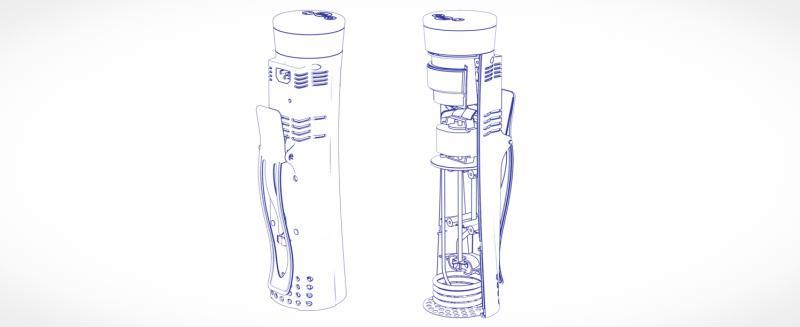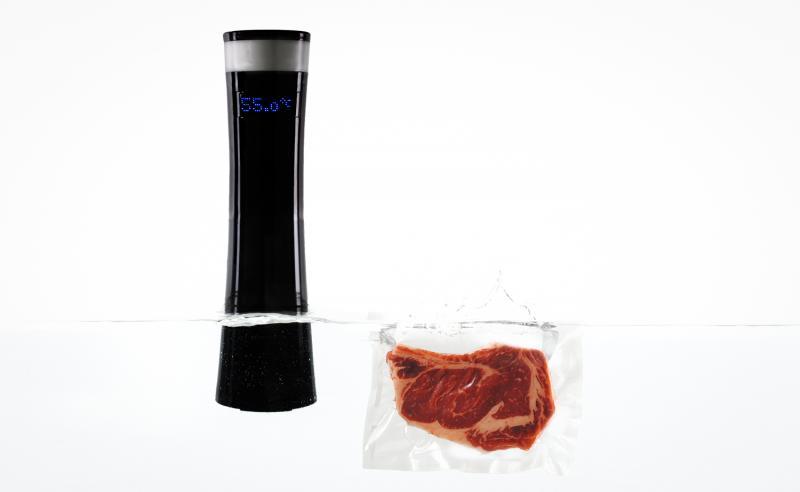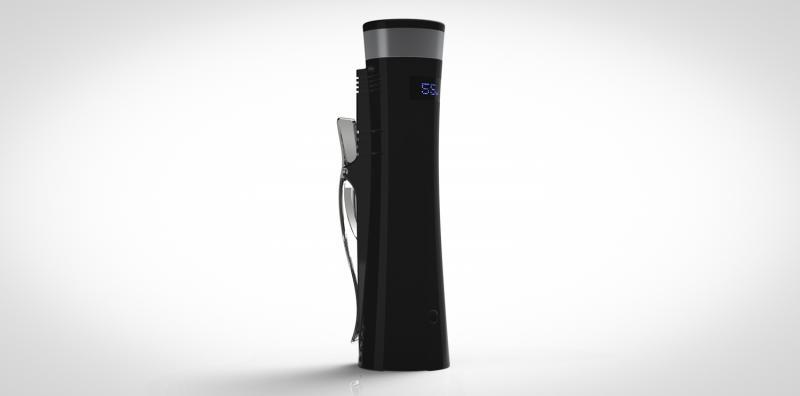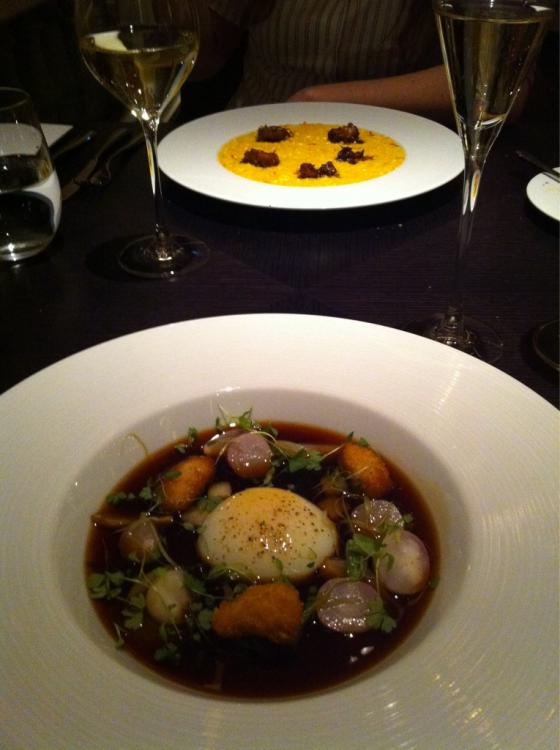-
Posts
19 -
Joined
-
Last visited
Content Type
Profiles
Forums
Store
Help Articles
Everything posted by Brainfoodie
-
There's a new SV circulator on Kickstarter by Scott Heimendinger, creator of the original Seattle Food Geek DIY sous vide many of us used as a reference and more recently appointed Director of Applied Research at Modernist Cuisine. It's called Sainsaire - i.e. without air, a play on "Sous Vide". The design and specs look good - 1KW heater, circulator, good clip to hold it to most containers - especially for the price: $199. With their permission I've attached some images to this post showing the general blueprint and prototype design. On the last update they've also confirmed they would do a 240V version if pledges reach $250K, which looks very likely as it's already at $214K after only two days. Kickstarter link: http://www.kickstarter.com/projects/seattlefoodgeek/sansaire-sous-vide-circulator-for-199 Main website: http://www.sansaire.com Good review with action photos over at Serious Eats: http://www.seriouseats.com/2013/08/we-test-the-new-low-price-sansaire-sous-vide-ciculator-from-modernist-cuisine.html I'm looking to replace my complex and slightly unsafe DIY unit but didn't pledge for the Nomiku as I thought it was expensive and risky. This one however seems to hit the spot and comes from a well known SV expert. Any thoughts?
-
The BBC had an interesting article comparing the horsemeat fraud to the sub-prime crisis that triggered our current economical problems. http://www.bbc.co.uk/news/magazine-21463838 As most will remember that was when good quality financial products were "packaged" with very poorly performing ones, but overall rated as good as the best they included and sold as such. One S&P analyst - who are now being sued for those misleading ratings - is even quoted as e-mailing: "We rate every deal. It could be structured by cows and we would rate it." Well it turns out that the problem is these same analysts are the ones running the big agro and food business too. This map showing the complex network behind a frozen lasagna makes it even clearer: http://www.bbc.co.uk/news/special/panels/13/feb/horsemeatroute/img/graphic_1360859117.gif How can the most cost effective method of making a cheap lasagna be a French manufacturer ordering from another French meat processor that in turn orders the meat from a subcontractor in Cyprus, who then orders the meat from a Dutch trader, who then actually buys it from Romanian abattoirs?
-
I love following what's going on with food in Asia and found these two from Singapore to be top quality: Cuisine & Wine Asia: http://itunes.apple.com/gb/app/cuisine-wine-asia/id533464792?mt=8 Epicure: http://itunes.apple.com/gb/app/epicure-magazine/id496228116?mt=8 The free "Open House Foodservice" (Australia) is also interesting: http://itunes.apple.com/gb/app/open-house-foodservice-magazine/id424156274?mt=8
-

Transporting glass bottles in airplane luggage
Brainfoodie replied to a topic in Food Traditions & Culture
I have a few bottle AirPacks which do the job really well, much better than bubble wrap. You can even post them. http://www.airpacksystems.com/glass-bottle-packaging-single.asp -
The user interface in that Crossland is terrible! Even the vendor can't seem to work it out smoothly... I would like to move on from my Pavoni, but think I'll wait for the CC2...
-

Kirkland Signature Premium Chocolates of the World Assortment Jar
Brainfoodie replied to a topic in Ready to Eat
Kirkland is Costco's own brand, so don't expect too much. I do like some of Costco's stuff, but wouldn't consider any of it to be upper tier quality. -
Thanks for the bubble wrap tip PedroG. Just wondering if bubble wrap copes with > 85C sous vide temperatures? Is the FMM container a standard size? I have a DIY sous vide setup on a 1/1 Gastronorm polycarbonate container and I'm considering buying an insulated box for it. There are some called Thermoboxes (think it's from a company called Thermo Future). They an't cheap (about $50) but promise a drop of only 2C per hour and handle temperatures up to 120C. Plus I can use them to actually transport food or keep stuff cold too. May be an option for the FMM if it's close to the GN sizes.
-
The book is already out in the UK and in stock at places like Amazon UK. The price is great too, 50% off so it costs just £15 (~ $24). Impressive for such a high quality printing and paper - not to mention the content.
-
Got the book yesterday (thanks to Amazon Prime), it's nicely done, very informative both in the discussions on flavour and the actual recipes. I was surprised it actually has a whole chapter on Sous Vide - , think that's new for a "at home" book - with 6 recipes covering meat, fish and an interesting "Fennel in smoked duck fat" I'm quite excited to give them a go, so started with the rack of of lamb cooked for one hour at 60C, in plenty of aromatics (rosemary, bay and thyme). Should be ready in a hour :-) Also have a pork belly brining now for the "Cocotte of pork [belly] with black pudding sauce" (the belly is sous vide for 18 hours at 60C) From what I seen the rest of the recipes are also very good - like the salad with edible "sand" made of dried olives, or the fish pie with "sea" foam. It's funny that the book not only has a chapter on desserts but another one on "Biscuits, snacks and drinks". Finally I think the Health and Safety directorate will raise issues with the recipe for "Chicken with clams a la plancha" which involves cooking with a pan of "oil [..] hot enough so that the pan erupts into flames when you shake it".
-
According to the FDA it should be safe to use them if used for brief periods of time at temperatures under 70C (160 F). Never use them in the microwave though or with items that may scratch it. http://www.fda.gov/Food/ResourcesForYou/Consumers/ucm199525.htm These days I still use mine to mix cold items, but probably will get rid of them eventually.
-
"Sopa de Pedra" comes from an old Portuguese legend of a monk who wanted to make a soup but no one has giving him anything so he said "well I'll have to make a soup with only a stone then". Villagers felt sorry for this and started giving him more and more ingredients to add. Anyway eventually this became a local speciality of Almeirim, in the north of Portugal. It's a very meaty soup (no seafood!!) and the now official ingredients are: red kidney beans (partially mashed) pig's ear blood sausage chorizo smoked pork belly potatoes onions garlic bay leaf coriander and of course salt and pepper In the traditional restaurant they used to serve it with a (large, easy to see) stone too, but I'm not sure that's still allowed by EU laws..
-

Baking (Etc.) with David Lebovitz's "Ready for Dessert"
Brainfoodie replied to a topic in Pastry & Baking
Finally made the Racines cake today WITH the cocoa nibs (got a whole kilo by Callebaut, if anyone in the UK needs a bit PM me Wow what a difference. It's my favorite cake now, without the nibs I thought it was just OK. Also try it as recommended with some orange blossom flavored whipped cream. It's a perfect match. And +1 on the metric measurements, wish all the books had them instead of the spoon/cups craziness. -
An old colleague tweeted this photo of "Broth of Lamb" and "Rice and Flesh", two of the starters from the opening today.
-
Thanks to annachan and others for mentioning Sandra Lee, being from the old continent I had never heard of her but her videos are just a fountain of laughs. Of course at the same time it's disconcerting that she actually published 20 cookbooks, including some bestsellers... Is she still doing new shows?
-
We're really not spoiled for choice up in Newcastle, even high end places like the Jesmond Dene House leave a lot to be desired. Most good food around here I make it myself. However one nice place that hasn't been mentioned is Little Saigon, a Vietnamese restaurant in Bigg Market (city centre). Quite genuine compared to the other generic Asian eateries around, the food is fresh and not greasy. See http://www.littlesaigon.uk.com/ for details. Outside central Newcastle, in the places you mentioned, the best option would be fish and chips :-)
-
If you feel like going for quick and easy I would suggest Kraze Burger in the Arrivals floor. They have pretty decent burgers, with some local flavour options you can try. Always seems to have airline staff around too. Try the chilli fries
-

Baking (Etc.) with David Lebovitz's "Ready for Dessert"
Brainfoodie replied to a topic in Pastry & Baking
Delicious book. My favourite so far is the Bahamian Rum Cake (p. 68). Soft, buttery and moist with all the rum-licious. Make sure you make the glaze and use dark sugar for that, it really adds another level. Only problem is there doesn't seem to be any left after 3 days around the house, which is a shame as it just gets better with time. Also made the Marjolaine (p. 28) twice. Looks and tastes stunning, and easier to make compared to other versions I have. On the first go I felt all that creme fraiche was making the cake too tangy so replaced it with the usual heavy cream in the chocolate ganache. I think that improved it. The Irish Coffee cupcakes (p 38) glazed in chocolate with the hidden surprise were very good. The Guiness-Gingerbread (p. 36) cupcakes were interesting and looked amazing, but like the ale not to everyone's tastes. The only one I didn't particularly like was the Banana Cake with Mocha frosting (p. 62). The taste of the ripe banana puree (2 cups, quite a lot) did not go at all with the rest of the cake, esp the frosting. Maybe the bananas were too ripe or the chocolate (Cacao Barry Excellence 55%) wasn't the best match, not sure. -
Wow I've just joined eGullet and there's a topic on Feijoada already. I'm a native Portuguese (but been living here and there..) so I feel I must add my input to this discussion :-) I do love the Brasilian version which introduces different ingredients such as the different salted meats, black beans and farofa but let's put the misconceptions of this thread to rest: this dish was born in the north of Portugal, and then imported and adapted to what was available in Brazil. Similar to how curry is now UK's national dish :-) The original Portuguese is version quite different (but also delicious) and the finished result looks like this: The recipe: 800 grams dried red kidney beans 300 grams smoked pig's nose 300 grams smoked pig's ear (note: in Portugal they sell both the smoked nose and ear together) 1 smoked pig's trotter 300 grams de Portuguese thin salami (salpicão) sliced 1 chorizo in 5mm slices 600 grams de salted pork ribs 1 or 2 Portuguese black puddings (morcela) 1 large onion - chopped 4 Tbsp oilive oil 250 grams pancetta or pork belly 2 large carrots - sliced 1 cabbage chopped in 2-3cm large strips 1 thai chilli (same as malagueta) 1 bay leaf A few cloves (optional) salt e pepper Soak the red beans in water the day before. Cook beans in just enough water (about 3 fingers above the beans) and some salt, until well done but not to the point of bursting... drain but keep the water. Scrub and wash the pigs ears, nose, trotters and belly. Boil them together with the black pudding in fresh water with some salt. Remove as they are well done, e.g. the nose usually cooks faster. Keep the water. Drain the meats and roughly chop into large chunky bits and the black puddings into 1cm slices. Sautee the onion and carrot in the olive oil for 2-3mins. Add the salami, chorizo and black pudding. Sauté for 2-3 more minutes until they colour the mixture. Add the chopped meats, bay leaf and cloves. Leave to cook for 5 minutes. Add the cabbage together with some of the water from the beans and meats , half a cup of each or more as needed, but the sauce shouldn't be too watery.. When the cabbage is soft add the cooked beans and sliced black pudding. Add the chilli pepper and season with salt as needed. It's much better done the day before to let the flavours develop and then just reheating to serve. Always served with white boiled rice (can be slightly dried in the oven) and sometimes tender-stem broccoli. This is not topped with farofa flour. Goes well with a nice Pinot Noir :-) I'm sorry if this is a bit of a rough description, if there's interest I might put up a better version and take some photos of my own. There are also some regional differences within Portugal, e.g. to the south it's not uncommon to use refogado (the Portuguese sofritto) as the base instead of just onions.





